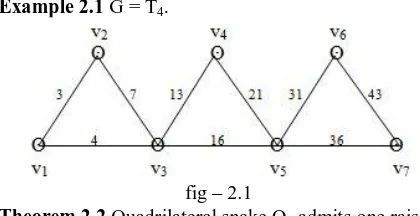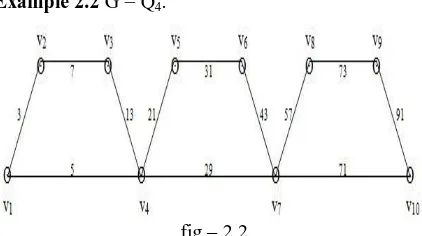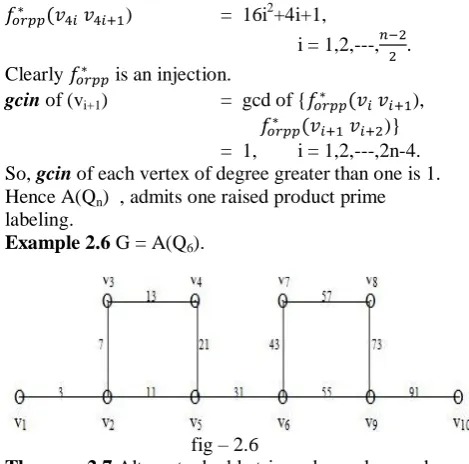455
One Raised Product Prime Labeling of Some Snake
Graphs
Sunoj B S1, Mathew Varkey T K2
Department of Mathematics, Government Polytechnic College, Attingal, Kerala, India1 Department of Mathematics, TKM College of Engineering,Kollam, Kerala, India2
spalazhi@yahoo.com1 ,mathewvarkeytk@gmail.com2
Abstract- One raised product prime labeling of a graph is the labeling of the vertices with {1,2---,p} and the edges with product of the labels of the incident vertices plus 1. The greatest common incidence number of a vertex (gcin) of degree greater than one is defined as the greatest common divisor of the labels of the incident edges. If the gcin of each vertex of degree greater than one is one, then the graph admits one raised product prime labeling. Here we investigate some snake graphs for one raised product prime labeling.
Index Terms-Graph labeling; product; prime labeling; prime graphs; snake graphs.
1. INTRODUCTION
All graphs in this paper are simple,finite and undirected. The symbol V(G) and E(G) denote the vertex set and edge set of a graph G. The graph whose cardinality of the vertex set is called the order of G, denoted by p and the cardinality of the edge set is called the size of the graph G, denoted by q. A graph with p vertices and q edges is called a (p,q)- graph.
A graph labeling is an assignment of integers to the vertices or edges. Some basic notations and definitions are taken from [1],[2],[3] and [4] . Some basic concepts are taken from Frank Harary [1]. In this paper we investigated one raised product prime labeling of some snake graphs.
Definition: 1.1 Let G be a graph with p vertices and q edges. The greatest common incidence number (gcin) of a vertex of degree greater than or equal to 2, is the greatest common divisor (gcd) of the labels of the incident edges.
2. MAIN RESULTS
Definition 2.1 Let G = (V(G),E(G)) be a graph with p vertices and q edges . Define a bijection f : V(G) {1,2,---, p} by f(vi) = i, for every i from 1
to p and define a 1-1 mapping : E(G) set of natural numbers N by = .The induced function is said to be one raised product prime labeling, if for each vertex of degree at least 2, the gcin of the labels of the incident edges is 1. Definition 2.2 A graph which admits one raised product prime labeling is called one raised product prime graph.
Theorem 2.1 Triangular snake Tn admits one raised
product prime labeling.
Proof: Let G = Tn and let v1,v2,---,v2n-1 are the vertices
[image:1.595.307.517.602.710.2]of G.
Here |V(G)| = 2n-1 and |E(G)| = 3n-3. Define a function f : V {1,2,---,2n-1} by
f(vi) = i , i = 1,2,---,2n-1
Clearly f is a bijection.
For the vertex labeling f, the induced edge labeling is defined as follows
) = i2+i+1, i = 1,2,---,2n-2. ) = 4i2, i = 1,2,---,n-1. Clearly is an injection.
gcin of (v1) = gcd of { ),
)} = gcd of {3, 4}= 1.
gcin of (vi+1) = gcd of { ),
)} = gcd of {i2+i+1, i2+3i+3} = gcd of {2i+2,i(i+1)+1} = gcd of {i+1,i(i+1)+1} = 1, i = 1,2,---,2n-3.
gcin of (v2n-1) = gcd of
{ ), )}
= gcd of {(2n-2)(2n-1)+1, (2n-2)2}
= gcd of {2n-2, (2n-2)(2n-1)+1}
= 1.
So, gcin of each vertex of degree greater than one is 1. Hence Tn, admits one raised product prime labeling.
Example 2.1 G = T4.
fig – 2.1
Theorem 2.2 Quadrilateral snake Qn admits one raised
product prime labeling.
Proof: Let G = Qn and let v1,v2,---,v3n-2 are the vertices
of G.
456 Define a function f : V {1,2,---,3n-2} by
f(vi) = i , i = 1,2,---,3n-2
Clearly f is a bijection.
For the vertex labeling f, the induced edge labeling is defined as follows
) = i2+i+1, i = 1,2,---,3n-3. ) = 9i2-3i-1, i = 1,2,---,n-1. Clearly is an injection.
gcin of (v1) = gcd of { ),
)} = gcd of {3, 5}= 1.
gcin of (vi+1) = gcd of { ),
)} = 1, i = 1,2,---,3n-4.
gcin of (v3n-2) = gcd of
{ ), )}
= gcd of { (3n-2)(3n-5)+1, (3n-2)(3n-3)+1}
= gcd of {2(3n-2), (3n-2)(3n-5)+1}
= gcd of {(3n-2), (3n-2)(3n-5)+1}
=1.
So, gcin of each vertex of degree greater than one is 1. Hence Qn, admits one raised product prime labeling.
[image:2.595.311.539.149.277.2]Example 2.2 G = Q4.
fig – 2.2
Theorem 2.3 Alternate triangular snake A(Tn) admits
one raised product prime labeling, if n is odd and triangle starts from the first vertex.
Proof: Let G = A(Tn) and let v1,v2,---, are the
[image:2.595.75.286.404.522.2]vertices of G.
Here |V(G)| = and |E(G)| = 2n-2.
Define a function f : V {1,2,---, } by
f(vi) = i , i = 1,2,---,
Clearly f is a bijection.
For the vertex labeling f, the induced edge labeling is defined as follows
) = i2+i+1, i = 1,2,---,
.
) = 9i2-6i+1, i = 1,2,---, . Clearly is an injection.
gcin of (v1) = gcd of { ),
)} = gcd of {3, 4} = 1.
gcin of (vi+1) = gcd of { ),
)} = 1, i = 1,2,---, . So, gcin of each vertex of degree greater than one is 1. Hence A(Tn), admits one raised product prime
labeling.
Example 2.3 G = A(T5).
fig – 2.3
Theorem 2.4 Alternate triangular snake A(Tn) admits
one raised product prime labeling, if n is even and triangle starts from the second vertex.
Proof: Let G = A(Tn) and let v1,v2,---, are the
vertices of G.
Here |V(G)| = and |E(G)| = 2n-3.
Define a function f : V {1,2,---, } by
f(vi) = i , i = 1,2,---,
Clearly f is a bijection.
For the vertex labeling f, the induced edge labeling is defined as follows
) = i2+i+1, i = 1,2,---, .
) = 9i2, i = 1,2,---,
. Clearly is an injection.
gcin of (vi+1) = gcd of { ),
)} = 1, i = 1,2,---, . So, gcin of each vertex of degree greater than one is 1. Hence A(Tn), admits one raised product prime
labeling.
Example 2.4 G = A(T5).
fig – 2.4
Theorem 2.5 Alternate quadrilateral snake graph A(Qn) admits one raised product prime labeling, if n is
odd and quadrilateral starts from the first vertex. Proof: Let G = A(Qn) and let v1,v2,---,v2n-1 are the
vertices of G.
Here |V(G)| = 2n-1 and |E(G)| = . Define a function f : V {1,2,---,2n-1} by
457 Clearly f is a bijection.
For the vertex labeling f, the induced edge labeling is defined as follows
) = 16i2-20i+7,
i = 1,2,---, .
) = 16i2-12i+1,
i = 1,2,---, .
) = 16i2-12i+3,
i = 1,2,---, .
) = 16i2-4i+1,
i = 1,2,---, .
) = 16i2+4i+1,
i = 1,2,---, . Clearly is an injection.
gcin of (v1) = gcd of { ),
)} = gcd of {3, 5}= 1.
gcin of (vi+1) = gcd of { ),
)} = 1, i = 1,2,---,2n-3. So, gcin of each vertex of degree greater than one is 1. Hence A(Qn) , admits one raised product prime
labeling.
[image:3.595.64.540.85.765.2]Example 2.5 G = A(Q5).
fig -2.5
Theorem 2.6 Alternate quadrilateral snake graph A(Qn) admits one raised product prime labeling, if n is
even and quadrilateral starts from the second vertex. Proof: Let G = A(Qn) and let v1,v2,---,v2n-2 are the
[image:3.595.304.539.98.330.2]vertices of G.
Here |V(G)| = 2n-2 and |E(G)| = . Define a function f : V {1,2,---,2n-2} by
f(vi) = i , i = 1,2,---,2n-2.
Clearly f is a bijection.
For the vertex labeling f, the induced edge labeling
is defined as follows
) = 16i2-20i+7, i = 1,2,---, .
) = 16i2-4i-1,
i = 1,2,---, .
) = 16i2-12i+3,
i = 1,2,---, .
) = 16i2-4i+1,
i = 1,2,---, .
) = 16i2+4i+1,
i = 1,2,---, . Clearly is an injection.
gcin of (vi+1) = gcd of { ),
)} = 1, i = 1,2,---,2n-4. So, gcin of each vertex of degree greater than one is 1. Hence A(Qn) , admits one raised product prime
labeling.
Example 2.6 G = A(Q6).
fig – 2.6
Theorem 2.7 Alternate double triangular snake graph A(DTn) admits one raised product prime labeling, if n
is even and double triangle starts from the second vertex.
Proof: Let G = A(DTn) and let v1,v2,---,v2n-2 are the
vertices of G.
Here |V(G)| = 2n-2 and |E(G)| = 3n-5. Define a function f : V {1,2,---,2n-2} by
f(vi) = i , i = 1,2,---,2n-2
Clearly f is a bijection.
For the vertex labeling f, the induced edge labeling is defined as follows
) = 16i2-12i+3,
i = 1,2,---, .
) = 16i2-4i+1,
i = 1,2,---, .
) = 16i2+4i+1,
i = 1,2,---, .
) = 16i2-4i-1,
i = 1,2,---, .
) = 4i2+4i+1,
i = 1,2,---,n-2.
) = 3.
Clearly is an injection.
gcin of (v4i-2) = gcd of
{ ), )}
= gcd of {(4i-2)(4i-1)+1, (4i-2)(4i+1)+1}
= gcd of {2(4i-2), (4i-2)(4i-1)+1}
= gcd of {(4i-2), (4i-2)(4i-1)+1}
= 1, i = 1,2,---, .
gcin of (v4i-1) = gcd of
458 = gcd of {(4i-2)(4i-1)+1,
(4i-1)(4i)+1} = gcd of {2(4i-1), (4i-2)(4i-1)+1}
= gcd of {(4i-1), (4i-2)(4i-1)+1}
= 1, i = 1,2,---, .
gcin of (v4i) = gcd of { ),
)} = gcd of {(4i-1)(4i)+1, (4i)(4i+1)+1}
= gcd of {8i, (4i)(4i-1)+1} = gcd of {(4i),
(4i)(4i-1)+1} = 1, i = 1,2,---, .
gcin of (v4i+1) = gcd of
{ ), )}
= gcd of { (4i-2)(4i+1)+1, (4i+1)(4i)+1}
= gcd of {2(4i+1), (4i-2)(4i+1)+1}
= gcd of {(4i+1), (4i+1)(4i-2)+1}
= 1, i = 1,2,---, . So, gcin of each vertex of degree greater than one is 1. Hence A(DTn), admits one raised product prime
labeling.
[image:4.595.70.527.85.771.2]Example 2.7 G = A(DT6).
fig – 2.7
Theorem 2.8 Alternate double triangular snake graph A(DTn) admits one raised product prime labeling, if n
is even and double triangle starts from the first vertex. Proof: Let G = A(DTn) and let v1,v2,---,v2n are the
vertices of G.
Here |V(G)| = 2n and |E(G)| = 3n-1. Define a function f : V {1,2,---,2n} by
f(vi) = i , i = 1,2,---,2n.
Clearly f is a bijection.
For the vertex labeling f, the induced edge labeling is defined as follows
) = 16i2-20i+7, i = 1,2,---, .
) = 16i2-16i+4, i = 1,2,---, .
) = 16i2-12i+1, i = 1,2,---, .
) = 16i2-12i+3, i = 1,2,---, .
) = 16i2-4i+1, i = 1,2,---, .
) = 16i2,
i = 1,2,---, . Clearly is an injection.
gcin of (v4i-2) = gcd of
{ ), )}
= gcd of {16i2-20i+7, 16i2-12i+3}
= gcd of {8i-4, 16i2-20i+7} = gcd of {4i-2),
(4i-3)(4i-2)+1} = 1, i = 1,2,---, .
gcin of (v4i-1) = gcd of { ),
)} = gcd of {16i2-12i+3, 16i2-4i+1}
= gcd of {8i-2, 16i2-12i+3} = gcd of {4i-1),
(4i-1)(4i-2)+1} = 1, i = 1,2,---, .
gcin of (v4i) = gcd of { ),
)} = gcd of {16i2-12i+1, 16i2-4i+1}
= gcd of {8i, 16i2-12i+1} = gcd of {4i,
(4i-3)(4i)+1} = 1, i = 1,2,---, .
gcin of (v4i-3) = gcd of
{ ), )}
= gcd of {16i2-20i+7, 16i2-16i+4}
= gcd of {4i-3, 16i2-20i+7} = gcd of {4i-3),
(4i-3)(4i-2)+1} = 1, i = 1,2,---, . So, gcin of each vertex of degree greater than one is 1. Hence A(DTn), admits one raised product prime
labeling.
Example 2.8 G = A(DT4).
459 REFERENCES
[1] Apostol. Tom M, Introduction to Analytic Number Theory, Narosa, (1998).
[2] F Harary, Graph Theory, Addison-Wesley,Reading, Mass, (1972
[3] Joseph A Gallian, A Dynamic Survey of Graph Labeling, The Electronic Journal of Combinatorics(2015), #DS6,
Pages 1 – 389.
[4] T K Mathew Varkey, Some Graph Theoretic Operations Associated with Graph Labelings, PhD Thesis,



